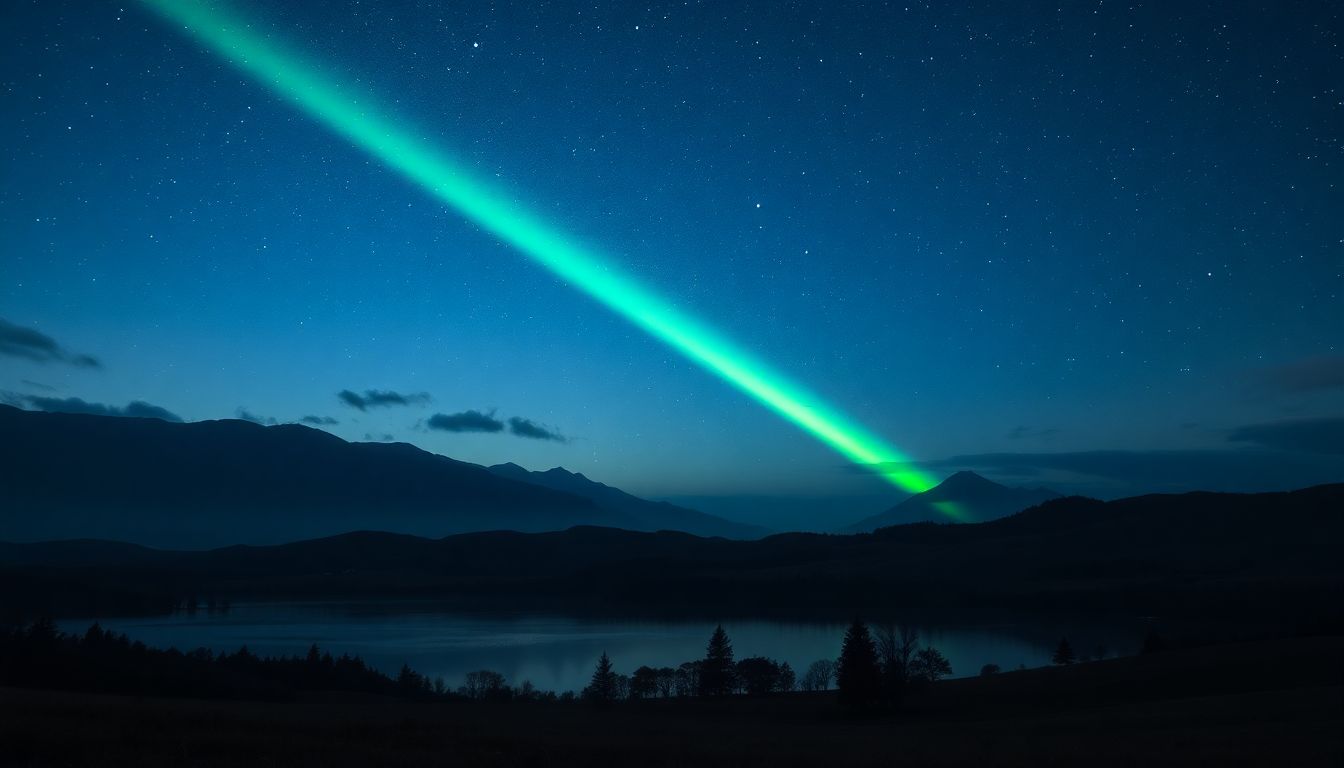
Why Do I See a Green Line in the Night Sky?
Introduction
Seeing a green streak in the night sky can feel magical and strange at the same time. It’s a sight many people wonder about, but few understand. What causes that glowing green line to appear? Knowing the reasons behind it helps us appreciate the natural wonders above us and clear up any wrong ideas. Some think it’s alien activity or mysterious signals but many times, science provides the real answer. Exploring these causes can help you recognize the different phenomena that light up our sky with green streaks.
What Is the Green Line in the Night Sky?
Explanation of the phenomenon
A green line or streak in the sky looks like a glowing trail. It can be faint or very bright, sometimes stretching across the entire sky. Usually, it appears as a brief flash or long streak, depending on what caused it. Some people see it as a glowing ribbon, others as a quick flash of green.
Common scenarios where it appears
This kind of light shows up during specific moments at night. It’s common during meteor showers when space rocks burn up in the atmosphere. It may also appear during atmospheric disturbances or near bright satellites. The phrase “green line” is popular among amateur astronomers and meteorologists who track sky phenomena.
Causes of a Green Line in the Night Sky
Atmospheric Phenomena
Aurora Borealis and Aurora Australis
The northern and southern lights are the most famous green sky phenomena. Charged particles from the sun hit the Earth’s magnetic field, creating colorful lights. When these particles collide with gases in the air, they produce shimmering green glows. Aurora Borealis is seen in places like Scandinavia and Canada. Aurora Australis lights up the southern parts like Australia and New Zealand.
Airglow
Airglow is a natural type of light that comes from the Earth’s atmosphere. It happens when atoms and molecules in the air release energy after being excited by sunlight or cosmic rays. Airglow can create a faint greenish hue across the night sky, especially when the atmosphere is clear and dark.
Astronomical Events
Meteors and Fireballs
When space debris enters our atmosphere at high speed, it heats up and burns. Some meteors are green because they contain specific chemicals. For instance, meteors rich in magnesium shine bright green as they burn. During big meteor showers, these streaks are more frequent and can make the sky look like it’s shimmering with green lines.
Satellite and Space Debris Trails
Satellites reflect sunlight as they orbit Earth. Sometimes, their reflection looks like a bright streak. Certain satellites, especially those with green reflective surfaces or solar panels, can produce green lines when viewed from the ground.
Human-Made Sources and Optical Effects
Laser Light Shows and Photography
Green lasers are popular in concerts and events. People sometimes see their beams streak across the sky or reflections in photos. These quick, bright lines can look just like natural phenomena. Some photographers capture these effects when taking long exposure shots at night.
Optical Illusions and Lens Effects
Occasionally, a camera lens creates artifacts that look like green lines. Lens flares or reflections inside the lens can produce streaks that seem to move or flicker. These are not real sky phenomena but optical illusions caused by the camera equipment.
Scientific Explanation of the Green Color
Chemical Composition and Emission Lines
Scientists have discovered that certain elements produce specific colors when they burn. Magnesium is a common culprit for the green hue. When magnesium atoms are heated during a meteor’s entry, they emit a bright green light at a specific wavelength. This is why many green meteors appear so vivid.
Physics of Light and Earth’s Atmosphere
When particles in our atmosphere get energized, they release photons—tiny packets of light. The spectral properties of gases like magnesium or oxygen favor green emissions. That’s why many natural light phenomena in the sky glow green—these emissions are strong and visible even from far distances.
How to Differentiate Between Causes
Observational Clues
Pay attention to how the line moves. Does it glide slowly or zip quickly? Is it bright or faint? The environment also matters. Clear, dark skies make green streaks easier to see. Light pollution or stormy weather can hide or distort these signals.
Using Technology
Many apps help identify satellites or upcoming meteor showers. If you see a green line, check if a satellite or meteor shower is active. Taking photos or videos can also help when analyzing the event later or asking experts for help.
Expert Insights and Case Studies
Scientists say that most green streaks are natural or man-made. For example, astronomers have studied meteor showers like the Perseids, known for green meteors. Researchers have also documented auroras that dance with emerald and green colors. Learning from these cases helps us distinguish between natural events and human activities.
Tips for Identifying and Responding to a Green Line in the Sky
- Track when and where you see the streak. Note weather and light pollution.
- Use apps to check if satellites or meteor showers are active.
- Record the moment with photos or video for better analysis later.
- If unsure, consult with astronomy groups or meteorologists. They can help identify what you saw.
Conclusion
Green lines in the night sky have many causes—from awe-inspiring natural phenomena like auroras to the fiery streaks of meteors or even reflections from human-made satellites. Understanding the science behind these sights helps us appreciate the sky’s mysteries. Whether it’s a harmless meteor or a beautiful aurora, each green streak is a reminder of how dynamic and fascinating our universe is. Keep observing, stay curious, and you’ll discover even more about the wonders above us.

